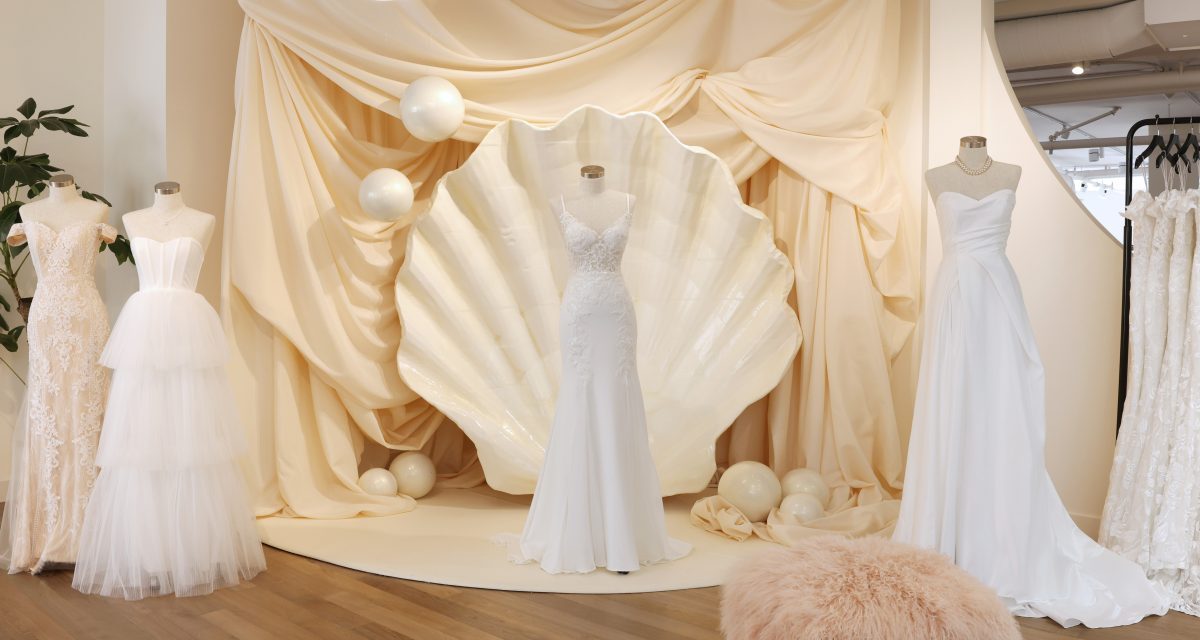As bridal retailers struggle, contemporary brands are swooping into the wedding market

More contemporary brands are taking their bridalwear strategies to the next level.
Earlier this month, Lulus — which sells affordable modern clothing for women — opened its first bridal boutique in Los Angeles. A week later, Disney released its first villain-inspired wedding gowns after first releasing princess-inspired bridal gowns with Allure in 2020. Vintage-inspired women’s clothing brand Staud has also launched an affordable bridal collection last year.
Contemporary brands are investing in the bridal category during a time when some of the traditional players in the wedding industry are struggling to stay afloat. David’s Bridal filed for bankruptcy in April and was sold in July to Cion Investment Corp after getting hit by inflation, the pandemic and changing shopping preferences. But data from jewelry company Signet Jewelry suggests that engagements are expected to climb this year, which signals an opportunity for apparel brands to cater to brides’ preferences.
“Fashion is fickle,” said Sky Canaves, senior analyst of retail and e-commerce at Insider Intelligence. “To stay ahead of the game, the brands and designers constantly have to innovate and look for opportunities to expand into adjacent categories that will resonate with both their existing consumers and appeal to new consumers.”
A growing number of shoppers are expected to appear in the bridal market. Signet Jewelry’s data indicates that there are expected to be 2.5 million engagements in 2024 compared to around 2.2 million in 2023. Apart from the potential to attract new customers, offering bridalwear also allows brands to offer higher-priced SKUs that offer high profit margins.
Many of these brides might not be interested in the look that traditional bridal shops offer. “There’s still a white space opportunity for more brands,” Canaves said. “There are especially strong opportunities for brands or designers that are already known for dresses or dressy apparel because they may find that their customers are already wearing their dresses to weddings.”
Special events like weddings are already a big area of opportunity for brands that are expanding into the category. During its third-quarter earnings call in November, Lulu’s Fashion Lounge Holdings said it saw double-digit positive net revenue comps for wedding-related apparel. The company began releasing size-inclusive bridal pieces in 2020.
Gabriella Santaniello, founder of A Line Partners, said contemporary brands have the opportunity to deliver to the needs of brides during every step of the wedding process; Lulus, for example, advertises wedding dresses, bachelorette party dresses and rehearsal dinner outfits on its website. When the company opened its Melrose bridal boutique, it said it wanted to “deliver an elevated, end-to-end wedding attire shopping experience.”
Santaniello said that contemporary brands also have an opportunity to offer items at a more affordable price than traditional dress shops.
“There’s a whole new attitude towards weddings,” she added. “There’s just nothing wrong with getting a dress that’s off the rack.”
Santaniello added that a brand’s aesthetic might also be a big draw for shoppers that are already drawn to the brand’s image. Much like Lulus, Staud is also offering affordable wedding dresses at around $900 or less. The bridal collection, which was launched mid last year, was inspired by Staud founder Sarah Staudinger’s own wedding — a buzzy event that was featured on Vogue.
Disney, on the other hand, has based its wedding collection off of characters people might already know and love. Disney’s dresses, in partnership with Allure Bridals, are inspired by characters like Ursula from The Little Mermaid and Maleficent from Sleeping Beauty. Now, Disney is also trying to cater toward different aesthetics with its villains collection, which features dark-colored fabrics. Disney got into the wedding dress business after its theme parks have proven to be a popular wedding venue for thousands of couples every year.
In its bankruptcy filing, David’s Bridal cited shifting consumer preferences as one of the reasons for its financial woes. “An increasing number of brides are opting for less traditional wedding attire, including thrift wedding dresses,” the company said in its filing.
Despite the opportunity in the bridal category, breaking into it is by no means easy, Santaniello said. Unlike a traditional bridal brand, some contemporary retailers don’t offer alterations or the elevated dress shopping experience such as access to a stylist and champagne services. Lulu’s is one exception, as the brand has said its new boutique will offer brides the chance to meet with a stylist bridal concierge service, and has other touches like a complimentary non-alcoholic beverage service.
Brands that have attempted to enter the bridalwear category in the past have seen mixed results. For example, J.Crew discontinued its wedding dress collection in 2016. Racked’s reporting at that time indicated that producing outfits for a niche business — which often involved materials like silk, beads and tulle — was “financially inefficient.” Meanwhile, Anthropologie Weddings — formerly called BHLDN — continues to invest in growth initiatives like pop-ups.
“There’s nothing quite like shopping for a wedding dress,” Santaniello said. “It’s very emotional, and you have this connection with the brand or the person who designed your dress. I think that also hooks the customer.”

